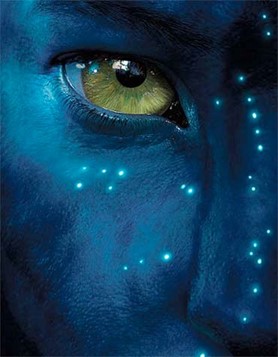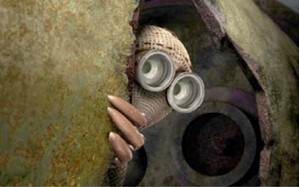
Note added in 2023: This chapter, written in 2012, refers only to the first film. I found the second film highly disappointing.
THE most potent expressions of the Singularity Archetype continue to be science-fiction novels and films. More so than their counterparts in the genres of horror, action, comedy, drama, etc, science-fiction movies and texts are a forward-thinking species, extrapolatory of both modern technological trends and humanity’s ultimate fate against the backdrop of space and time. James Cameron’s Avatar is particularly charged with emergent archetypal messages from the collective unconscious that relate to an approaching evolutionary event horizon. Yet some of Avatar‘s most significant layers of meaning have been overlooked. Most glaringly, they are not to be found in the articles available on the web that discuss the film’s underlying mythology (at least that I have been able to find). Avatar, as we’ll see, has numerous points of connection with the Singularity Archetype and the Glorified Body.
The Will Toward the Glorified Body in Avatar
The will toward the Glorified Body is right at the center of Avatar. James Cameron seems to be aware of this. When Larry King asked him why he picked the name “Avatar,” Cameron responded: “When I wrote it in 95’ it just popped into my head that here you’ve got people projecting their consciousness into a fleshly body, a biological body, and that’s what the Sanskrit word means, the taking of flesh, the incarnation of a divine being in the case of the Hindu religion. And although our characters aren’t divine beings, obviously, the idea is that it’s actually a fleshly incarnation.”
As Avatar opens, our point of view is that of a Glorified Body, the flying dream body of the protagonist, Jake Sully, a young Marine who is a paraplegic. His character is perfectly designed to represent the will toward the Glorified Body. He is an athletic, vital young man with great physical courage and a warrior essence but whose body is half-paralyzed.
The next hauntingly numinous scene in the movie is when Jake first catches a glimpse of his avatar. As I pointed out in the previous chapter, “avatar,” a term that has been adopted in the computer gaming world, comes from Hindu mythology and means a spirit form descended into the flesh. From that point of view, a human being is an avatar, a spirit bound to one body for the entire waking portion of an incarnation. We also have an intense will to break free of the one-body/one-psyche rule that dominates the waking mortal life. The movie Avatar, thanks to both content and the technological enhancements of its form, provides a powerful depiction of what it would be like to break the one-body/one-psyche rule. Jake cannot restrain his unbridled euphoria when he is able to enter his avatar, a far more powerful and glorified body than he had even before his paralysis. His new body is bioluminescent, idealized, more androgynous, and suited to a world where gravity is less limiting than on the earth. From the movie production standpoint, this is a virtual body that is a hybridization of the actor’s body moving through space and time and a CGI avatar.
Breaking the One Body/One Psyche Rule
As I’ve already mentioned, we all get to break the one-body/one-psyche rule during the dreamtime, when we are able to merge our awareness with a variety of dream bodies. Avatar begins with the liberated feeling of Jake flying in his dream body. The process of merging with the avatars of the movie is very much like dreaming. Jake lies down in a coffin-like capsule and, analogous to falling asleep and dreaming, his connection to his waking body is submerged as he bonds to a different, enhanced body that lives in Pandora, a place analogous to the Dreamtime. The Dreamtime is a place of boundary dissolution. Everyone who has seriously studied the Dreamtime, including both Freud and Jung, has noticed how telepathic it is compared to waking time. Many of the reports of mutual dreaming illustrate this dramatically. Similarly, the bioluminescent world of Pandora is a massively telepathic network. I’ll return to the concept of telepathic networks later in this essay.
Avatar and Near-Death Experience
The process of merging with the avatar also has many parallels to near-death experience. Jake dies to his waking life, passes through a tunnel of light, and finds himself in a glorified body. Jake’s life takes on a diurnal/nocturnal sort of cycle that undergoes a figure/ground reversal. The waking life of his paraplegic body recedes with the ghetto life of corporeal limitations, bureaucratic tensions, and intrusions from imperialistic patriarchy. His Eros and enthusiasm for life become far more identified with his avatar/Pandoran life. He wants tofully escape the inferior corporeal/waking life into the Glorified Body/Dreamtime/afterlife.
Paradoxically, Cathy Lynn Pagano wrote an article entitled “Avatar: The Archetypal Message Is ‘Get Back In Your Body!’” Pagano points out, quite insightfully, “The freedom and joy of the body moving, leaping, daring is a major component of this story, just as Pandora’s beauty compliments the body’s freedom. The corporate people live in metal boxes, without beauty or free movement; the walking which was such a big part of the game of golf is reduced to putting in the office.”33
The paradox she does not recognize is that Jake gets back into ‘the body,’ or more correctly, he becomes more vitally embodied by breaking free of the limitations of his damaged human body and merging with his avatar.
Subcreating Imaginal Worlds
“It’s my world, you are all just living in it.”
— James Cameron (referring to Pandora), on Larry King Live
While from the top layer of Avatar’s mythology, Pandora is an exotic, extraterrestrial world, on both a more literal and deeper layer, Pandora is actually the world of the empowered human imagination. Pandora is an imaginal world created by James Cameron. As I’ve pointed out before, movies are essentially a dream delivery technology. Cameron, who, unlike most of us, can command a thousand technicians and a quarter-billion-dollar budget, is able to make his dream, his imaginal world, into a collective dream. His world is, of course, more an extrapolation of human psychology than anything extraterrestrial. For example, since I am a baby boomer like Cameron, I notice a common cultural influence that very likely inspired the bioluminescent world of Pandora. An early psychedelic experience for many baby boomers, including myself, was the backroom of various hippie shops where black lights illuminated black-light posters and created a little phosphorescent world reminiscent of the look of nocturnal Pandora. The avatar experience of the movie,-
33 http://www.opednews.com/articles/Avatar-The-Archetypal-Mes-by-Cathy-Lynn-Pagano-100121-
11.html.
-therefore, represents to me not so much extraterrestrial travel as intrapsychic imaginal travel, which has more to do with the Dreamtime, the future of virtual reality, and a human evolutionary event horizon we are hurtling toward.
By my second viewing of the movie, much of the novelty was gone, and I found that I really wanted a 3D IMAX immersive visit to another exotic world, which would be much more exciting than a revisit to Pandora.
Naviblue Syndrome
Apparently, many people, mostly young men, complain on internet forums of depression because they can’t live on Pandora, which seems so real to them, while they are watching the film in 3D. For example, CNN, in an article entitled “Audiences experience ‘Avatar’ blues,” reports:
“A user named Mike wrote on the fan Web site ‘Naviblue’ that he contemplated suicide after seeing the movie.
“‘Ever since I went to see Avatar, I have been depressed. Watching the wonderful world of Pandora and all the Na’vi made me want to be one of them. I can’t stop thinking about all the things that happened in the film and all of the tears and shivers I got from it,’ Mike posted. ‘I even contemplate suicide thinking that if I do it I will be rebirthed in a world similar to Pandora and that everything is the same as in Avatar.’”34
The ‘Naviblue’ phenomenon is understandable because so many in our culture are magically disempowered. They want to live in someone else’s dream because it doesn’t occur to them that they are dreamers and potential subcreators who can create their own worlds. They have been conditioned to be passive consumers of the imaginal plane, not empowered creators.
Opening Pandora’s Box
What is envisioned on the other side of the evolutionary event horizon is that the physics of the Dreamtime will be the default, rather than the physics of the waking time, and we will have the ability to subcreate our own worlds without access to a thousand technicians and a quarter-billion dollars. I have also pointed out that unlike Terence McKenna and Ram Das, whom I have talked to a bit on the subject, I do not expect this evolutionary breakthrough to be a cure for human evils. When novelty-
34 http://www.cnn.com/2010/SHOWBIZ/Movies/01/11/avatar.movie.blues/index.html.
-increases, the outer edge of light and dark both intensify, and I expect that there will be gifted black magicians making potent diabolical use of these enhanced abilities. I think the name “Pandora” suggests this with its connection to Pandora’s Box. Pandora opened a jar in the original myth, but a mistranslation has rendered it forever into a box. Now the word “Pandora” has been remythologized again and will forever be associated with the world of the Na’vi. Avatar represents an opening of Pandora’s Box in the sense that it is a breakthrough in the technological magic of the movies, and now that the technology has been irretrievably loosed into the world, we can be sure that it will not always be used to deliver collective dreams as benign as Avatar.
Liminality and the Special Role of Hybrids in Evolution
The luminescent jellyfish-like envoys of Eywah, the divine intelligence of Pandora, recognize Jake as a key evolutionary catalyst. In many ways, to the practical intelligence of both human and Pandoran characters, he is the most unlikely of choices. He is severely handicapped in both the human and Pandoran realms, is not particularly bright, and is woefully ignorant of Pandoran culture as well as foolish about human politics. What he does have, however, that makes him the ideal choice is an enthusiastic beginner’s mind. As the Pandoran shaman points out, “It’s hard to fill a cup that is already full.” His lack of knowledge is also ideal cinematically as we learn things for the first time as he does. Jake is a liminal figure, a person caught betwixt and between, who is not fully accepted in either realm. As is so often the case, that which is liminal and hybrid is the most alchemically charged and capable of metamorphosis.
Twins and Evolution
Another aspect of Jake that makes him an evolutionary catalyst is that he is a twin. His call to adventure comes because of the murder of his twin, who was trained to merge with a Na’vi avatar. Twins are very significant mythologically but also from an evolutionary point of view. A new type of consciousness also means a new type of communication, and the new means of communication can easily be what creates the new type of consciousness. The last quantum evolutionary jump had to do with our ability to think and communicate in words. The breakthrough into a more sophisticated form of communication is very likely to happen (both in the past and the future) between identical twins. Identical twins sometimes invent their own languages. (Sometimes called idioglossia or cryptophasia or less technically as “twin talk” or “twin speech.”) Identical twins are a maximal case of rapport that can exist between individuals, and with lessened barriers of difference and miscommunication, they seem like the most fertile ground for crossing the communication gap between individuals in novel ways.

In another 2009 CGI film, 9, a masterpiece that, unlike Avatar, did not get the credit it deserved, we see a brilliant manifestation of the twin aspect of the Singularity Archetype. Amongst a group of prototype rag-doll-like creatures, there is a pair of twins. While the other prototypes have lens-like eyes that take in visual information, the twins have eyes that transmit information as light between them. They are also able to project moving images to others. As we’ve discussed, visual telepathy is one of the most classic aspects of the Singularity Archetype. Also amazing is that 9 ends with some of the creatures in luminous spirit bodies merging with a moving spiral of light in the sky, another classic element of many of the permutations of the Singularity Archetype.

The Ego and the Pandoran Telepathic Network
Jake, because of the murder of his human twin, is invited to merge with a new twin, his avatar, which has been grown to match his murdered twin genetically. When this twinned being (Jake in his avatar) travels to Pandora, he finds himself in a logos-beheld kind of world where most or all of the life is bioluminescent, transmitting information about itself through the projection of light. It is also a world that has much in common with another key aspect of the Singularity Archetype — the telepathic network. All of Pandora seems to be a telepathic network. The human world of the movie, even though it is set in the future, is as ego-fractured as ever, with human psyches encapsulated by their own short-sighted, egocentric perspectives.
Like the human characters of the imagined future in Avatar, we have reached an evolutionary cul-de-sac with the ego. Given the lethality of our present level of technology, we may no longer be able to survive the egocentric perspective. Unlike the Na’vi, the egocentric human is usually unaware, except in an abstracted way, of the living matrix of which he is a part. Encapsulated by technological exoskeletons — SUVs, gadget-filled homes, etc. — he may have no direct sense of how his lifestyle is impacting the rest of the living matrix. The problem of the insulated ego is already a very familiar theme, and the ego is all too easy to villainize, but the prejudice against the ego so often found in New Age and Eastern circles fails to notice that the ego served many powerful evolutionary purposes.
One of the great purposes of the ego was to encapsulate consciousness and create a firewall between psyches, greatly reducing the networked telepathy that I believe is more the norm in nature. We see what looks like networked telepathy, for example, in the amazing synchrony of schools of fish. Peter Thompson and Christopher Bird’s The Secret Life of Plants and some subsequent studies show that the vegetable kingdom is not only sentient but aware of human thoughts and changes to living tissue (while remote from any sensory information). Tribal cultures do seem to be more aware and tapped into the networked intelligence of nature.
Pandora and the Pre/Trans Fallacy
The Na’vi resemble an idealized version of a terrestrial indigenous tribe, and that constitutes a subtle danger in the mythological resonance of the film. The danger is that the film encourages what Ken Wilber calls the “pre/trans” fallacy.
Essentially, the pre/trans fallacy notices a common tendency to confuse prerational states with transrational states since both are non-rational. The “reductivist” version of this is the tendency of “scientism,” which reduces all transrational mystical states to prerational infantilism and dismisses authentic spiritual experience as “superstitious nonsense.” Freud clearly fell for this half of the fallacy, especially in The Future of an Illusion. The “elevationist” version of the fallacy, ubiquitous in the New Age, is to elevate prerational states to the transcendent and to demonize rationality. From this side of the fallacy, babies are thought to be Buddhas, and anything tribal or aboriginal is romanticized and inflated as infinitely superior to anything modern or rational. Promiscuity is seen as a daring rebellion from antiquated taboos, even though it is usually in high conformity to what peers are doing. They recognize as conventional the older sexual morays of the past but fail to recognize that their rebellion is part of a vast conventionalism of the present and that this new conventionalism is actually based on a still more primitive level of development than the old conventionalism. Regressing to prerational hedonism, indulging every impulse and irrational notion is seen as enlightened, post-conventional, and transcendent. This is the state of the typically goofy New Age person who never heard an urban legend or bit of mystical-sounding nonsense without adopting it wholesale. This type of person is fiercely anti-intellectual and anti-rational, so it is impossible to talk them down from their absurdities. Even the attempt to do so casts you, in their minds, as this clueless rationalist stuck in his ego. They believe they have transcended rationality while forgetting that to transcend something, you first have to achieve it!35
The glorification of the Na’vi, especially since they appear not only exotic and tribal, but are also occurring in a futuristic sci-fi film, will encourage some people to believe that the answer to our present troubles would be a return to life as warriors in an indigenous rain-forest tribe. The Singularity Archetype, however, indicates that the answer has more to do with hybridization — of East and West, of aboriginal with high tech, of past and future. Jake, who appears amongst the Na’vi as a hybrid, is a better personification of the evolutionary message than the Na’vi themselves. Unfortunately, Jake’s character is disappointingly ordinary. He has a good heart and physical courage but little else to recommend him as the evolutionary catalyst he becomes in the film. From a marketing and story point of view, however, Jake’s ordinariness makes him easier for young males to identify with. Also, in many traditional hero cycles, the hero is a naïve young male who has to be initiated into a new world, and Jake fits very well into that tradition. In most of the more inspired versions of stories related to the Singularity-
35 For more on the pre/trans fallacy and the error of absolutisms, see my essay “Dynamic Paradoxicalism: The Anti-ism Ism” at ZapOracle.com.
-Archetype, however, (Dune, Akira, many others), the evolutionary catalyst tends to be a young mutant with extraordinary parapsychological abilities.
Another way that Avatar leans toward the preconventional rather than the transconventional is that a kind of hard-wired interspecies bond with various animals is emphasized over the intraspecies, nonlocal telepathic bond that we find in more inspired story versions of the Singularity Archetype. There seems to be a pantheistic networking with nature, but it is imagined in a very primitive, materialist way where the Na’vi have tails that seem to be the organic equivalent of Ethernet cables. Since Cameron first conceived of the Na’vi in 1995, before Wi-Fi networking existed, their rudimentary means of connection is understandable. Schools of fish, however, don’t need to connect via nerve bundles to synchronize, so the networking model in the movie seems to have a bias toward the concrete, hard-wired connection. The imagined version of nature is actually more primitive than the already existing version of nature we find here on Earth.
Avatar and Homo gestalt
In more sophisticated and inspired versions of the Singularity Archetype, the transcendence of ego-encapsulation is not imagined in such a materialist pre-conventional way. Collective consciousness turns up frequently in expressions of the Singularity Archetype and merits some examination. In Theodore Sturgeon’s 1953 science-fiction novel, More Than Human, a group of mutants, who each have distinctly different strengths and weaknesses, form a collective consciousness while retaining some individuality and become, in many ways, a single entity where each mutant serves in a specialized role, as if they were organs of a single body. Sturgeon coined the term “Homo gestalt” to describe this new entity. Similarly, more recent abduction testimony has emphasized the “Greys” as having a hive-like collectivity, and this is experienced as another threatening aspect of their alien otherness.
There are a number of possible reasons for this collective consciousness motif appearing in so many permutations of this archetype. One is that it may be a fairly literal indicator of evolutionary change. If the ego ceases to dominate the human psyche, perhaps the boundaries it creates around the individual will dissipate, and we will become more collectively aware. The shells of the oysters dissolve, and the pearls lie together.
The Homo gestalt aspect of the Singularity Archetype reflects an evolutionary possibility. Encapsulated psyches become telepathically connected but without a loss of individuality. For example, in the world of Dune, a sisterhood of highly conscious warriors is known as the “Bene Gesserit.” To become a Bene Gesserit Reverend Mother, one must survive a perilous rite called “The Water of Life.” In this initiatory rite, one imbibes a potent psychotropic, mutagenic poison. If the initiate survives and becomes a Reverend Mother, she will retain her individuality but will also be aware of the memories and all the psyches of all other Reverend Mothers, living or dead, who have similarly survived this rite. The Reverend Mothers don’t need cables or funny tails to be part of this network.
Parapsychological researchers such as Russell Targ (the laser physicist who cofounded the U.S. Government’s remote viewing program) have long recognized that telepathy and many other parapsychological phenomena occur because our psyches exist in a nonlocal field. In other words, no signal needs to be sent anywhere because psyches do not need to be causally related. Early Soviet parapsychologists called telepathy “mental radio” because they imagined the psyche in the image of the preeminent machine of their era, the radio, and had a causal signal model. However, the findings of many well-conducted experiments have shown that the telepathic effect is not lessened by distance (as any energetic signaling would be), nor is it diminished when the subject is in a Faraday Cage (which blocks all electromagnetic signals). More evolved visions of Homo gestalt are based on the emergence of encapsulated individuality into a nonlocal telepathic network.
In the final battle at the end of Avatar, the military/industrial/ patriarchal complex is personified by Colonel Quaritch, who is encapsulated in an exoskeleton. Jake is in his avatar but ultimately is saved because of the telepathic bond with his Na’vi lover. For most of the film, Jake depends on a technological connection to his avatar — via a device that looks like a cross between an MRI machine and a particle accelerator. Later he transcends the technology and uses a mycelium-like organic network to permanently merge with his avatar.
Avatar as Cultural Milestone
Although I’ve been critical of what seem like failures of imagination in Avatar, I’d like to close this chapter with an appreciation of its immense significance for the collective. Earlier, I speculated that technology would provide a potent catalyst for our evolution into the imaginal realm when there was enough distributed computer power to provide real-time mapping of human facial expressions onto CGI avatars. In other words, at our present level of technology, people from various parts of the world can interact in a networked computer game like World of Warcraft through their individualized digital avatars. However, the richness of this virtual social experience is greatly lessened because the avatars are incapable of the complex visual communication enabled by the microsecond-by-microsecond changes of human facial expression. When we reach the point that your webcam can record your facial expressions and map them onto your real-time avatar, we will begin to approach the complexity of face-to-face social contacts in the virtual world. Avatar takes a crucial half step toward that because it advances the ability to give pre-rendered CGI avatars the complexity of the human form. In the making of Avatar, the actors each had a miniature camera with LED lights on a little boom in front of their face capturing minute changes in facial expression. The Na’vi avatars, especially since they were 3D, were a very significant advance from earlier live-action-into-CGI films like Beowulf (2007). With the well-handled bonding of Jake with his avatar and the powerfully immersive medium of 3D IMAX, we had the best collective experience to date of what it would be like to merge with a different body in a different world. Avatar represents a huge cultural milestone, though necessarily it is a mere phosphorescent shadow of what awaits us at the event horizon.
 ZapOracle.com home to the free 720-card Zap Oracle
ZapOracle.com home to the free 720-card Zap Oracle


